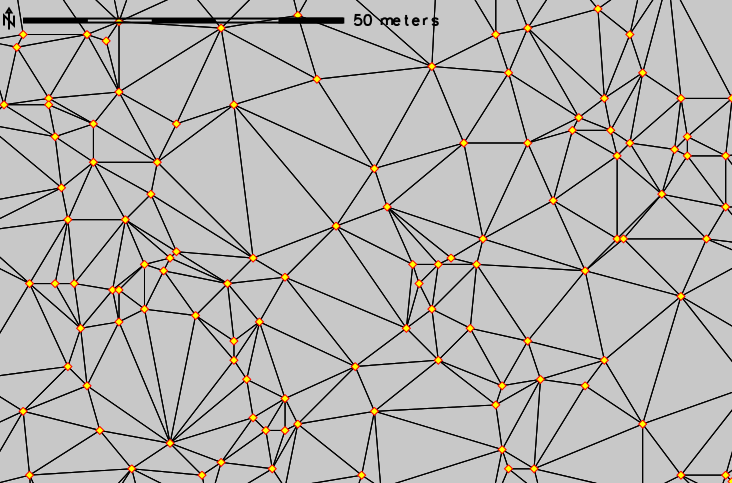v.delaunay
Creates a Delaunay triangulation from an input vector map containing points or centroids.
v.delaunay [-rl] input=name [layer=string] output=name [--overwrite] [--verbose] [--quiet] [--qq] [--ui]
Example:
v.delaunay input=name output=name
grass.script.run_command("v.delaunay", input, layer="-1", output, flags=None, overwrite=None, verbose=None, quiet=None, superquiet=None)
Example:
gs.run_command("v.delaunay", input="name", output="name")
grass.tools.Tools.v_delaunay(input, layer="-1", output, flags=None, overwrite=None, verbose=None, quiet=None, superquiet=None)
Example:
tools = Tools()
tools.v_delaunay(input="name", output="name")
This grass.tools API is experimental in version 8.5 and expected to be stable in version 8.6.
Parameters
input=name [required]
Name of input vector map
Or data source for direct OGR access
layer=string
Layer number or name ('-1' for all layers)
A single vector map can be connected to multiple database tables. This number determines which table to use. When used with direct OGR access this is the layer name.
Default: -1
output=name [required]
Name for output vector map
-r
Use only points in current region
-l
Output triangulation as a graph (lines), not areas
--overwrite
Allow output files to overwrite existing files
--help
Print usage summary
--verbose
Verbose module output
--quiet
Quiet module output
--qq
Very quiet module output
--ui
Force launching GUI dialog
input : str, required
Name of input vector map
Or data source for direct OGR access
Used as: input, vector, name
layer : str, optional
Layer number or name ('-1' for all layers)
A single vector map can be connected to multiple database tables. This number determines which table to use. When used with direct OGR access this is the layer name.
Used as: input, layer
Default: -1
output : str, required
Name for output vector map
Used as: output, vector, name
flags : str, optional
Allowed values: r, l
r
Use only points in current region
l
Output triangulation as a graph (lines), not areas
overwrite : bool, optional
Allow output files to overwrite existing files
Default: None
verbose : bool, optional
Verbose module output
Default: None
quiet : bool, optional
Quiet module output
Default: None
superquiet : bool, optional
Very quiet module output
Default: None
input : str, required
Name of input vector map
Or data source for direct OGR access
Used as: input, vector, name
layer : str, optional
Layer number or name ('-1' for all layers)
A single vector map can be connected to multiple database tables. This number determines which table to use. When used with direct OGR access this is the layer name.
Used as: input, layer
Default: -1
output : str, required
Name for output vector map
Used as: output, vector, name
flags : str, optional
Allowed values: r, l
r
Use only points in current region
l
Output triangulation as a graph (lines), not areas
overwrite : bool, optional
Allow output files to overwrite existing files
Default: None
verbose : bool, optional
Verbose module output
Default: None
quiet : bool, optional
Quiet module output
Default: None
superquiet : bool, optional
Very quiet module output
Default: None
Returns:
result : grass.tools.support.ToolResult | None
If the tool produces text as standard output, a ToolResult object will be returned. Otherwise, None will be returned.
Raises:
grass.tools.ToolError: When the tool ended with an error.
DESCRIPTION
v.delaunay uses an existing vector points map (input) to create a Delaunay triangulation vector map (output).
Delaunay triangulation example (red-yellow points are the data points from which the triangulation was generated):
EXAMPLE
Commands used with the North Carolina dataset to create the above figure (subset shown in figure).
g.region n=220750 s=219950 w=638300 e=639000 -p
v.delaunay input=elev_lid792_randpts output=elev_lid792_randpts_delaunay
REFERENCES
Leonid Guibas and Jorge Stolfi, (1985). Primitives for the Manipulation of General Subdivisions and the Computation of Voronoi Diagrams, ACM Transactions on Graphics, Vol 4, No. 2, April 1985, Pages 74-123
SEE ALSO
Delaunay triangulation (Wikipedia)
AUTHORS
Martin Pavlovsky, Google Summer of Code 2008, Student
Paul Kelly, Mentor
Based on "dct" by Geoff Leach, Department of Computer Science, RMIT.
SOURCE CODE
Available at: v.delaunay source code
(history)
Latest change: Tuesday Apr 22 12:23:50 2025 in commit 1512703
